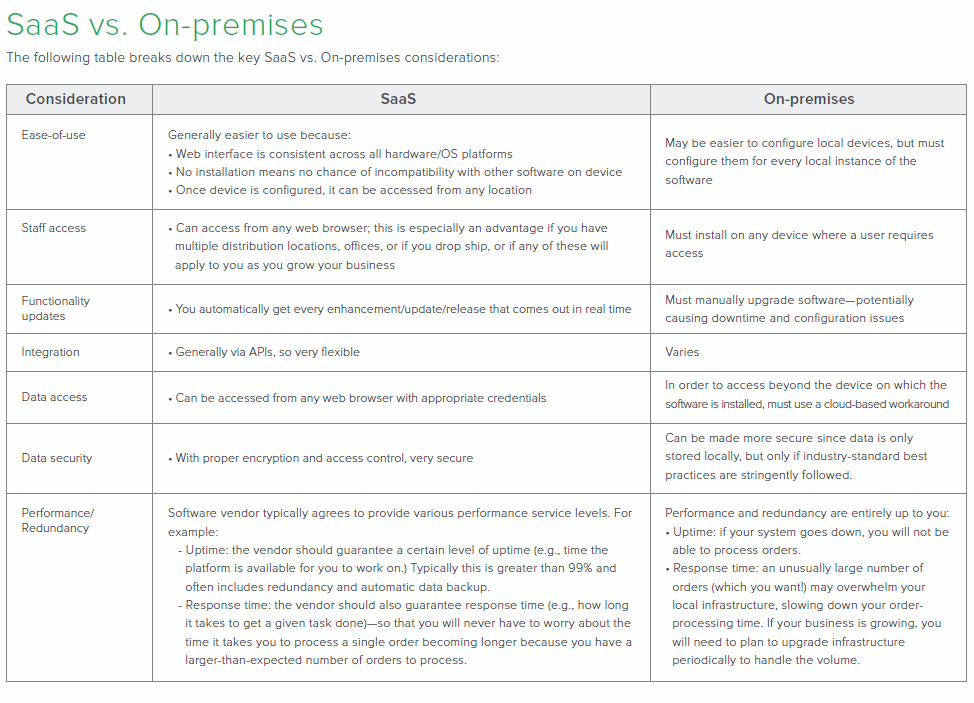When you’re on the hunt for shipping software that meets your needs as an eCommerce retailer, you’ll have to make many decisions. One important decision is whether you want to use a web-based SaaS (software as a service) solution, or an on-premises solution that needs to be installed. In this article, we’ll go over a few key considerations when deciding between the two. For a more in-depth look at this and literally every other consideration, download our free Definitive Guide to eCommerce Shipping.
Level of Tech Savvy
Let’s be honest. We’re not all gifted when it comes to navigating technology. We all have that relative that just can’t seem to figure it out, or maybe you are that relative (no judgement!). Either way, this is a key consideration when comparing shipping software solutions.
Ask yourself: who within the business will be using your shipping software? Are we all going to be using the same type of computer (Mac vs PC, for example, can require different plug-ins, drivers, and even file types)? Will you have someone who can install the software on all devices? How many licenses does your software come with? And if something breaks, what kind of service is available to you?
One of the key differences between a SaaS solution and an on-premises solution is that a SaaS product lives in the cloud. It exists entirely online without downloading anything to your computer (for the most part). This means updates happen behind the scenes without any manual work on your part. It also means that the user experience should be the same across all devices (especially if you all use the same type of browser, which we’ll get to in a second). An on-premises solution will need to be installed on every computer you’ll use, and you’ll need to have some sort of shareable storage set up (something like Google Drive, Dropbox, or your own intranet) so everyone has access to the same data and files.
If you have people of varying levels of tech savvy, people doing work in different locations or who are on-the-go, or you have no interest in monitoring upkeep, a SaaS solution is your best bet.
Advantage: SaaS
Number of Users
Another key consideration is how many people will be using the product. With a SaaS solution, either everyone can use the same login, or you can set up multiple user accounts for accountability purposes (depending on the software’s capabilities). Some SaaS solutions will limit the number of users per plan, others may not. With an on-premises solution, you will often need product keys to install the software onto multiple machines, and those are often not unlimited (to keep people from just handing out the product to anyone and everyone). This can lead to some problems if you have people in multiple locations or, as mentioned above, people who are not particularly savvy at installing and maintaining software.
Also, keep in mind that when product updates occur, each of those users will need to make sure they’ve properly installed those updates so everyone is running on the same version across the company.
Advantage: SaaS
Reliability of Ye Olde Internet
Anyone who works with the world wide web knows that sometimes it goes down. Whether it is a local internet outage, weather related issue, or some nefarious group disrupting nearly the entire internet, a web-based SaaS solution is at the mercy of your connection to the world. A benefit of an on-premises solution is you should be able to continue working with what you already have downloaded from your stores while you wait for everything to be right with the world again. With a cloud-based SaaS solution, you may as well go take a nap so you don’t drive yourself mad hitting the browser refresh button.
As mentioned above, a benefit of the SaaS solution is that the user-experience should be consistent no matter what computer you are on, as it’s not machine dependent. That being said, there is always the possibility of specific browser compatibility issues. What works one way in Google Chrome may work differently in Internet Explorer, and differently still in Mozilla Firefox. This can be a major headache if you have people using different browsers (hey, we all have our preferences) or if you have to jump onto a different computer to work. While most SaaS engineers will try to account for this, bugs and hiccups can exist everywhere and may take a little while to patch up and fix.
Advantage: On-premises
Who Wins the Shipping Software Showdown?
These are just a few considerations, and you should look at all aspects of a solution to make sure it fits your individual business needs. We find that a SaaS solution ticks more boxes than an on-premise one, not just because we make one, but because so many online retailers need the flexibility and convenience of a cloud-based solution.
Have more questions or want to really dive into all there is to know about eCommerce shipping and shipping software? Download our free Definitive Guide to eCommerce Shipping and become an expert. When you’re ready to save money and talk shipping for your eCommerce business, we’d be happy to show you a demo of how ours works.
Rob Zaleski
Latest posts by Rob Zaleski (see all)
- USPS 2023 Shipping Rate Changes - November 16, 2023


